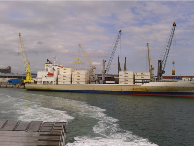 Reading reports on the meeting on complexity in organisations that took place in Vienna last week, I started reflecting on my own experiences of complexity. As a lapsed physicist, I know that it is a fundamental law of nature that disorder (which is often much the same as complexity) tends to increase with time. The only way to reverse this trend is to do work – and even then the reduction in disorder is only local. I can’t think of any experiences that suggest that this is not just as true for organisations as for nature in general!
Most managers focus mainly on what their own areas need. They seek to improve their areas by doing work (designing and introducing changes of many kinds), and often succeed – but frequently the local success may be at the expense of making the joining up with neighbouring areas worse: overall, complexity may have increased as a result of their work, just as the laws of thermodynamics say it should!
Reading reports on the meeting on complexity in organisations that took place in Vienna last week, I started reflecting on my own experiences of complexity. As a lapsed physicist, I know that it is a fundamental law of nature that disorder (which is often much the same as complexity) tends to increase with time. The only way to reverse this trend is to do work – and even then the reduction in disorder is only local. I can’t think of any experiences that suggest that this is not just as true for organisations as for nature in general!
Most managers focus mainly on what their own areas need. They seek to improve their areas by doing work (designing and introducing changes of many kinds), and often succeed – but frequently the local success may be at the expense of making the joining up with neighbouring areas worse: overall, complexity may have increased as a result of their work, just as the laws of thermodynamics say it should!
Agree key principles to manage complexity
Avoiding that problem is not easy, and only partial solutions are possible – managers have to be trusted to manage. It can help, however, to provide a top-down framework designed to fix key principles organisation-wide, and then to allow managers the freedom to develop local solutions to problems within that framework. A self-consistent set of- Vision and values
- Strategic objectives
- Simple and clear structure for decision making
- Delegated authorities and accountabilities
- Key metrics
Spotted from the Portsmouth to Cherbourg ferry – a container ship clearly branded ‘Fyffes’. To anyone in the UK (I’m not sure about elsewhere), that means only one thing: bananas.
How many bananas would you get on a banana boat? The banana boxes you see in supermarkets must be about 50cm x 35cm x 20cm (1/30 cubic metre) and I’d guess that they might hold about 100 bananas – so that’s something like 3000 bananas per cubic metre.
A standard container is about 2.4m x 2.4m x 12m, or 72 cubic metres – so that makes about 200,000 bananas per container. Its hard to tell how many containers there are on the boat, but perhaps 100? So maybe 20,000,000 bananas per ship – one between three for the entire population of the UK. That means we need a ship-load of bananas to arrive in Britain every day to provide the average 2 bananas a week that we each eat.
There are several interesting thoughts that follow from that. The first is simply the incredible logistical feat of providing that many ripe bananas, day in, day out, to shops across the land. Demand takes little account of seasons or weather, and bananas are quite easily damaged. Developing processes which can deliver that volume, in good condition and at the price people expect to pay, while having the resilience to cope with the vagaries of nature, is an impressive achievement. There is little to distinguish between one banana and another though – so its only getting those processes optimised that enables you to compete.
Another is the power of such rough and ready estimates. Starting from easy observations and guesses that anyone could make, we can get a pretty good estimate of shipping requirements: we might be 2x too big or small, but probably not much worse than that. Frequently there is no need for high precision, at least to start with, but the courage to estimate is not always easily found.
A final thought is the power of those little labels, When I was a child, it seemed as though every bunch of bananas had a Fyffes label on it. Fifty years later, the association is still instant. I’m not sure how that creates value for Fyffes (does it?), but the effect is unmistakable!
[caption id="" align="alignright" width="300"] Queueing for the Proms 2008 on the south steps of the Royal Albert Hall (Photo credit: Wikipedia)[/caption]
I’m sitting on the steps outside the Royal Albert Hall in London. Fortunately today it isn’t raining, but even if it was, I needn’t worry. These days the Proms have an excellent system for managing the queue – rather like the ones on the deli counters in supermarkets. When you arrive, you are given a numbered ticket, which guarantees your place in the queue. Once you have your ticket, you can wander off for a coffee or a snack, or take shelter if it rains, knowing that everyone will be admitted in the order they joined the queue regardless. It is not particularly sophisticated – but it is a simple system, and it works.
Simplicity is hard-fought-for: it does not happen by accident. Once a complex process or system is in place, changing it to remove unnecessary complexity is hard, just as all change is. Even stopping a simple system getting more complicated needs constant vigilance: otherwise, it is likely to gather exceptions and special cases, as well as extra checks that seem important, but which have a cost which is frequently overlooked. Just as nature dictates that the disorder of the Universe (or a teenager’s bedroom) increases with time, and that this can only be reversed by the input of work, so it is with organisations.
Why does it matter? Because a simple system is inherently more efficient and less error-prone. Have you tried to explain your organisation’s processes to a new joiner? If so, how easy do you find it to explain the judgements required if the process has branches (if this, then that, but if not, then the other), and how quickly do people learn to make them properly? Good governance depends on people following the rules. Complexity makes it more likely that people will make mistakes, and also makes it harder to spot when people deliberately try to get round rules. For an extreme example of what happens with complexity, think about tax codes: with complex rules and many special cases, expert advisers earn a good living, which must be at the expense of either the tax-payer or the tax-collector or both. While that is good for the experts, does that not make its complexity bad for the rest of us?
Queueing for the Proms 2008 on the south steps of the Royal Albert Hall (Photo credit: Wikipedia)[/caption]
I’m sitting on the steps outside the Royal Albert Hall in London. Fortunately today it isn’t raining, but even if it was, I needn’t worry. These days the Proms have an excellent system for managing the queue – rather like the ones on the deli counters in supermarkets. When you arrive, you are given a numbered ticket, which guarantees your place in the queue. Once you have your ticket, you can wander off for a coffee or a snack, or take shelter if it rains, knowing that everyone will be admitted in the order they joined the queue regardless. It is not particularly sophisticated – but it is a simple system, and it works.
Simplicity is hard-fought-for: it does not happen by accident. Once a complex process or system is in place, changing it to remove unnecessary complexity is hard, just as all change is. Even stopping a simple system getting more complicated needs constant vigilance: otherwise, it is likely to gather exceptions and special cases, as well as extra checks that seem important, but which have a cost which is frequently overlooked. Just as nature dictates that the disorder of the Universe (or a teenager’s bedroom) increases with time, and that this can only be reversed by the input of work, so it is with organisations.
Why does it matter? Because a simple system is inherently more efficient and less error-prone. Have you tried to explain your organisation’s processes to a new joiner? If so, how easy do you find it to explain the judgements required if the process has branches (if this, then that, but if not, then the other), and how quickly do people learn to make them properly? Good governance depends on people following the rules. Complexity makes it more likely that people will make mistakes, and also makes it harder to spot when people deliberately try to get round rules. For an extreme example of what happens with complexity, think about tax codes: with complex rules and many special cases, expert advisers earn a good living, which must be at the expense of either the tax-payer or the tax-collector or both. While that is good for the experts, does that not make its complexity bad for the rest of us?
 Queueing for the Proms 2008 on the south steps of the Royal Albert Hall (Photo credit: Wikipedia)[/caption]
I’m sitting on the steps outside the Royal Albert Hall in London. Fortunately today it isn’t raining, but even if it was, I needn’t worry. These days the Proms have an excellent system for managing the queue – rather like the ones on the deli counters in supermarkets. When you arrive, you are given a numbered ticket, which guarantees your place in the queue. Once you have your ticket, you can wander off for a coffee or a snack, or take shelter if it rains, knowing that everyone will be admitted in the order they joined the queue regardless. It is not particularly sophisticated – but it is a simple system, and it works.
Simplicity is hard-fought-for: it does not happen by accident. Once a complex process or system is in place, changing it to remove unnecessary complexity is hard, just as all change is. Even stopping a simple system getting more complicated needs constant vigilance: otherwise, it is likely to gather exceptions and special cases, as well as extra checks that seem important, but which have a cost which is frequently overlooked. Just as nature dictates that the disorder of the Universe (or a teenager’s bedroom) increases with time, and that this can only be reversed by the input of work, so it is with organisations.
Why does it matter? Because a simple system is inherently more efficient and less error-prone. Have you tried to explain your organisation’s processes to a new joiner? If so, how easy do you find it to explain the judgements required if the process has branches (if this, then that, but if not, then the other), and how quickly do people learn to make them properly? Good governance depends on people following the rules. Complexity makes it more likely that people will make mistakes, and also makes it harder to spot when people deliberately try to get round rules. For an extreme example of what happens with complexity, think about tax codes: with complex rules and many special cases, expert advisers earn a good living, which must be at the expense of either the tax-payer or the tax-collector or both. While that is good for the experts, does that not make its complexity bad for the rest of us?
Queueing for the Proms 2008 on the south steps of the Royal Albert Hall (Photo credit: Wikipedia)[/caption]
I’m sitting on the steps outside the Royal Albert Hall in London. Fortunately today it isn’t raining, but even if it was, I needn’t worry. These days the Proms have an excellent system for managing the queue – rather like the ones on the deli counters in supermarkets. When you arrive, you are given a numbered ticket, which guarantees your place in the queue. Once you have your ticket, you can wander off for a coffee or a snack, or take shelter if it rains, knowing that everyone will be admitted in the order they joined the queue regardless. It is not particularly sophisticated – but it is a simple system, and it works.
Simplicity is hard-fought-for: it does not happen by accident. Once a complex process or system is in place, changing it to remove unnecessary complexity is hard, just as all change is. Even stopping a simple system getting more complicated needs constant vigilance: otherwise, it is likely to gather exceptions and special cases, as well as extra checks that seem important, but which have a cost which is frequently overlooked. Just as nature dictates that the disorder of the Universe (or a teenager’s bedroom) increases with time, and that this can only be reversed by the input of work, so it is with organisations.
Why does it matter? Because a simple system is inherently more efficient and less error-prone. Have you tried to explain your organisation’s processes to a new joiner? If so, how easy do you find it to explain the judgements required if the process has branches (if this, then that, but if not, then the other), and how quickly do people learn to make them properly? Good governance depends on people following the rules. Complexity makes it more likely that people will make mistakes, and also makes it harder to spot when people deliberately try to get round rules. For an extreme example of what happens with complexity, think about tax codes: with complex rules and many special cases, expert advisers earn a good living, which must be at the expense of either the tax-payer or the tax-collector or both. While that is good for the experts, does that not make its complexity bad for the rest of us?  Years ago, I was managing the sale of a business division. The business was based on carrying out a highly-specialised technical test on clients’ products, and each time a test was carried out, it made a loud bang. This would have been of no concern if it had not been that they were carried out in a large workshop also used for other activities. However, checks had been made and the noise levels were within legal safety limits.
Just before signing the deal, we happened to mention to the purchaser that we had some tests scheduled for the next day, and he said he’d like to send someone round to check the sound levels. It was a beautiful summer’s day – until their measurements showed that the bangs were over the limit. What a toe-curling moment! Clearly, we had made the wrong assumptions.
In the end it was not as bad as it seemed: a sound-attenuating box solved the problem without making access too difficult, at quite modest cost and with only a few weeks’ delay. But the proving tests provided another surprise – the noise levels were legal again without the box. The reason – we now realised – was that the humidity of the air could affect its sound-attenuating properties.
Years ago, I was managing the sale of a business division. The business was based on carrying out a highly-specialised technical test on clients’ products, and each time a test was carried out, it made a loud bang. This would have been of no concern if it had not been that they were carried out in a large workshop also used for other activities. However, checks had been made and the noise levels were within legal safety limits.
Just before signing the deal, we happened to mention to the purchaser that we had some tests scheduled for the next day, and he said he’d like to send someone round to check the sound levels. It was a beautiful summer’s day – until their measurements showed that the bangs were over the limit. What a toe-curling moment! Clearly, we had made the wrong assumptions.
In the end it was not as bad as it seemed: a sound-attenuating box solved the problem without making access too difficult, at quite modest cost and with only a few weeks’ delay. But the proving tests provided another surprise – the noise levels were legal again without the box. The reason – we now realised – was that the humidity of the air could affect its sound-attenuating properties.
Avoiding wrong assumptions
Conclusion 1 – Make sure you know what factors can affect your assumptions. Wrong assumptions may lead to disaster. Conclusion 2 – Don’t rely on conclusion 1! If something is critical, don’t rely on a modest safety margin – do what you can to increase it early, in case there is something you have not anticipated.
What happens when an organisation grows up? Many things, but it is not so different from a child growing up: it develops organisation maturity.
As a child grows up, it develops its own habits, values, behaviours. It makes friends. It learns how to do things it could not do before. And it learns how to blend and adapt all of those things to create a consistent whole – its personality. With that comes self-confidence.
So it is with an organisation. In a young organisation – even a large one, perhaps formed from a merger – processes and structures may have been patched together un-adapted from different inheritances. Initially, the mixture of values, relationships, and so on, is unlikely to be self-consistent. Although they may be individually very experienced, managers are not used to working together, and do not know how each other will react in different circumstances. Trust takes time to develop.
Even for an established organisation, a major disruptive change in its environment can cause the same difficulties. The new environment is unfamiliar and the managers of the organisation may have varying responses. Confidence and trust in each other’s judgement in the new situation need to be re-established. Perhaps new people join the team. Processes and systems may need to be changed, because the organisation and its strategy are no longer aligned.
Nobody expects a small, young organisation to behave like a major corporation. However, with scale comes expectation. If you look like a grown-up, people expect you to behave like a grown-up and to have grown-up relationships. Just as with a child who looks much older than it is, the incongruity can cause difficulty for everyone.
Organisational self-confidence – maturity if you will – matters. When an organisation knows at all levels that ‘this is the way we do things round here’, everyone in it can stand their ground with confidence if they need to, in the knowledge that all their colleagues would back them up. Where there is underlying inconsistency, people do not have that confidence. Then it can feel as if you are standing on your own, rather than backed by a team - the whole is not greater than the sum of the parts. So an organisation in this situation needs to grow up fast.
What does it take to do something about this?
First, recognise the nature of the problem. Fundamentally the challenge is about joining things up. That makes it multi-dimensional, multi-functional, crossing all the silos. That in itself means the response has to be driven or at least supported from the top. It also means that it is best done by someone with no vested interest in the outcome. And while it will require detailed analytical work to understand and correct specific problems, it will also need influencing and people skills to ensure that the solutions are accepted and embraced.
I have worked in a number of organisations which have faced challenges of this sort, and helped them to find their way through them. If you are facing similar challenges which you would like to discuss, please contact me at david@otteryconsulting.co.uk.
 Want to kill a good conversation dead instantly? Tell someone you are a physicist!
The editorial column in a professional magazine I sometimes read asked recently ‘what does “physics” mean to you?’ And it’s a good question – which I don’t propose to answer here! But it did set me thinking about what I mean when I say I am a physicist (yes, you guessed, I am), even though it is many years since I have done anything which would normally be called physics.
Want to kill a good conversation dead instantly? Tell someone you are a physicist!
The editorial column in a professional magazine I sometimes read asked recently ‘what does “physics” mean to you?’ And it’s a good question – which I don’t propose to answer here! But it did set me thinking about what I mean when I say I am a physicist (yes, you guessed, I am), even though it is many years since I have done anything which would normally be called physics.




